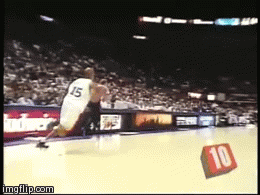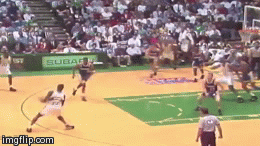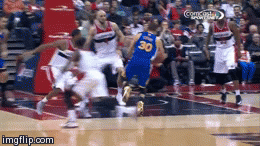Centers of Attention
In honor of Tuesday’s Manute Bol Bobble-head Night, I wanted to consider the Warriors’ recent history at the center position. I started watching during the Don Nelson/Run TMC era, and I’ve witnessed a revolving door of Nellie-ball novelty acts and exploitive experimentations (Bol, Chris Weber), stiffs and busts (Alton Lister, Todd Fuller). So I was wondering, who’s been Golden State’s best modern big man, and why, and does the answer provide us with any blueprint for a future fit in the team’s “big” picture?
Let’s lump the most notable recent bigs* into two overly generalized categories: Masquerading Power Forwards and Under-Skilled Stiffs.
Masquerading Power Forwards (Top Ten):
10) Carlos Rogers–Special sub-category of over-hyped, misused forwards; see Anthony Randolph
9) Anthony Tolliver–Are you kidding me?! Excluding Golden State this guy played more SF than C in his career!
8) Andrew DeClercq, 7) Chris Gatling–Represent vintage Nellie era run-and-gun, small-ball, out of position players
6) Clifford Robinson, 5) Jermaine O’Neal–Last-hurrah, headbanded retreads
4) Marreese Speights, 3) Al Harrington–Prototypical stretch fives
2) Rod Higgins–Slightly before my time, but the epitome of the Nellie-ball SF/C
1) Webber–Sent the franchise into a decades-long spiral and still easily tops this list
Under-Skilled Stiffs (Top Ten):
10) Todd Fuller (Tim Young, Patrick O’Bryant)–Character/size over skill draft busts that cost us at minimum Kobe Bryant, Manu Ginobili, and J.J Redick
9) Uwe Blab (Les Jepsen, Jim Petersen, Lister)–You can’t have a stiff list without a Blab–these guys represent the straw-man archetype of Golden State center history
8) Marc Jackson, 7) Victor Alexander–What they produced on O they gave back on D, and then some
6) Bol–Anomaly turned cult-hero; represents the best of Nelson’s creativity
5) Andris Biedrins–Points for longevity, but his ranking this high says more about the Warriors than him
4) Adonal Foyle–Defense and sportsmanship will take you far on this list
3) Erick Dampier–Moody big was the most well-rounded center we’d had in decades, but he was average at best
2) Rony Seikaly–Best offensive skill set on stiff list, which only means he had more than one go-to move
1) Andrew Bogut–Pretty pitiful that our best big by far has, due to injury, absolutely no shooting touch and spends most offensive sets in the post-extended with his back to the basket
C-Webb V. The Agile Aussie: And The Winner Is…
Webber and Bogut represent mostly opposing skill sets, with the main similarity being their gift for passing. Offensively, Webber had a remarkable handle and driving ability, along with a solid, medium explosive finish, while Bogut’s feel and confidence around the hoop are suspect. However, Bogut is a human (semi-legal) pick, opening up teammates on and off the ball, while I can’t remember a Webber screen that wasn’t simply a place-holder precipitating his own roll to the hoop. And while Webber was undersized and overmatched on defense, it’s more than that–Bogut sees the defensive end like a chessboard, like the most astute point guards see offensive sets, sizing up not only his man’s talents and tendencies, but all would-be drivers’ likely routes of attack to the basket, providing perfectly timed rim protection, generally retaining possession after blocks, as well as delivering hard, message fouls when necessary; I’m struggling to recall an instance of Webber help-D.
Webber provided one glorious year of excitement, followed by a twelve year curse; Bogut was slow to assimilate and injury prone, but he’s contributed to two consecutive playoff runs and is now the offensive and defensive hub for the best team in the league. Despite health issues and limited traditional offensive assets, Andrew Bogut is clearly the Warriors’ best modern big.
Lessons Learned?
So what can we glean from this little drive down memory lane? Well, a majority of these guys were short-term Warriors and/or single-skill players. Continuity and development seem key to the Warriors’ success. Nelson v. Webber and the ensuing trade/retirement sent the organization into a tailspin, and the Monta Ellis/Bogut move had a similar potential, with Steph Curry’s suspect ankles and the fan-base/Joe Lacob divide (plus budding Mark Jackson disquiet) on full public display at Chris Mullin’s jersey retirement. But by extending Curry and Bogut despite their injury histories, and retaining Klay Thompson and David Lee, the Warriors established a cohesion that has allowed them to not only withstand a coaching overhaul, but thrive within a group mentality in a shockingly short amount of time.
Skill Sets
As far as skills, it’s essential that NBA players possess at least two but preferably three or more skills, the basketball equivalent of five-tool (average, power, base-running, throwing, and fielding) baseball players. Overly simplified: shooting, driving, passing, rebounding, and defending (blocks, steals, denials, etc.). While Bogut can’t shoot or drive, his passing, picks, rebounds, and blocks make him a multi-tool threat, the perfect compliment for an offensively prolific team. That’s why it’s imperative for Festus Ezeli to develop that jump-hook/etc. to go along with his D and boards, to separate him from the Foyles and Biedrins of the past.
We Must Protect This House! (Riding The Wave)
Another key to the bigs’ development has been protecting them and putting them in positions to succeed. Requiring Webber at 6’9″ to play center was one thing, but surrounding him with an offensive-minded SF turned PF in Billy Owens and backing him up with similarly undersized, offense-first bigs like Alexander and Gatling was a recipe for disaster. Conversely, Draymond Green is a smaller four, but grounding him with a defensive anchor like Bogut and a developing buoy like Ezeli, as well as two-way cruisers Thompson and Harrison Barnes as well as a speedboat like Curry allows their skills to rise to the surface and for them to fluidly function and flourish as a unit. Likewise, Thompson, Barnes, and Green (along with subs Andre Iguodala, Shaun Livingston, and Justin Holiday) provide interchangeable switch-ability on D that protect Curry’s newfound defensive cavalierness and Bogut’s tricky foul issues. Green’s studied defensive sagging counteracts Curry’s occasional head-turns and lack of adherence to ball-you-man mantra, while Thompson’s, Iguodala’s, and Livingston’s wingspans block all passing lanes, along with Bogut’s savant-like guile and timely rim-protection.
The point here is defensive fluidity, and it flows from the man in the middle. Bogut’s presence, reputation, and intelligence allow Curry-a heretofore defensive liability-to take advantage of his defensive assets (speed and quickness) by dogging his man with the foreknowledge that Bogut literally has his back. It also allows Green to go chest-to-chest with the opponent’s most skilled big, knowing Bogut-help is lurking; and it encourages those fungible pterodactyls (Thompson, Barnes, Livingston, etc.) to gamble and trap imperviously. Offensively, the sets also circulate through Bogut–despite his lack of range or drive, he untraditionally sets up just inside the perimeter, establishing sail-size drag screens on and off the ball. Or he encamps with the rock, methodically insisting the play run it’s course, be it a rim-flash, backdoor cut, illicit with-ball pick-and-pass, or a staggered dribble followed by a touch-less hook.
As always with Bogut- the pachyderm in the post- the central issue is health. This season’s discovery of a degenerative knee issue has changed his injury status from the freakish (elbow, rib, etc.) to the persistent, meaning his days of effectiveness are numbered. But even if the Warriors don’t re-sign him the year after next, they finally have a formula for “big” success–multi-skilled steeds that compliment each other within a team and organizational concept.
Posted by:DT
January 29, 2015
January 29, 2015
*For the purposes of this post, my sample-size was limited to Golden State players listed as centers from the ’89/’90 season-the present, as per http://www.basketball-reference.com/




Pingback: Centers Of Attention | Tertiary Smoke